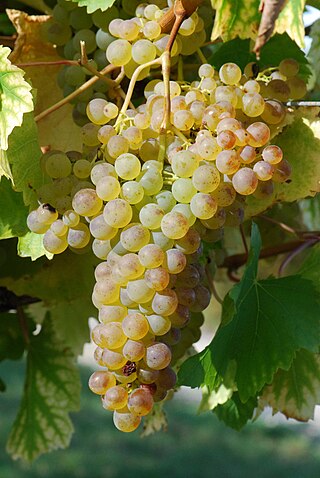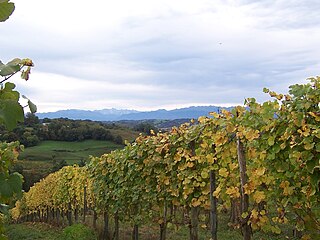
Merlot is a dark blue–colored wine grape variety, that is used as both a blending grape and for varietal wines. The name Merlot is thought to be a diminutive of merle, the French name for the blackbird, probably a reference to the color of the grape. Its softness and "fleshiness," combined with its earlier ripening, make Merlot a popular grape for blending with the sterner, later-ripening Cabernet Sauvignon, which tends to be higher in tannin.

Cabernet Franc is one of the major black grape varieties worldwide. It is principally grown for blending with Cabernet Sauvignon and Merlot in the Bordeaux style, but can also be vinified alone, as in the Loire's Chinon. In addition to being used in blends and produced as a varietal in Canada and the United States, it is sometimes made into ice wine in those regions.

Folle blanche, also known as Picpoule, Gros Plant, and Enrageat blanc, is a wine grape variety from southwest France. It was the traditional grape variety in Cognac and Armagnac production until the 20th century. Folle blanche is an offspring of Gouais blanc, with the other parent so far unidentified.

Colombard is a white French wine grape variety that may be the offspring of Chenin blanc and Gouais blanc. This makes the grape the sibling of the Armagnac Meslier-Saint-François and the nearly extinct Cognac grape Balzac blanc.
Gros Verdot is a red French wine grape variety that was a historically important grape in the Gironde wine region of Bordeaux but plantings of the variety have been banned in the region since 1946 with the grape no longer being a permitted variety in any AOC Bordeaux wines.

Mondeuse noire is a red French wine grape variety that is grown primarily in the Savoy region of eastern France. The grape can also be found in Argentina, Australia, California, Switzerland and Sicily. Plantings of Mondeuse noire was hit hard during the phylloxera epidemic of the mid to late 19th century which nearly wiped out the vine from eastern France. While the grape recovered slightly in the 20th century, French plantations of Mondeuse noire fell sharply in the 1970s, with just over 200 hectares left in France in 2000. In the early 21st century, it seems the variety has increased somewhat in popularity, as it can give good wines if the planting site is chosen carefully.
Bouchalès or Grapput is a red French wine grape variety that is grown primarily in Bordeaux and Southwest France wine appellations. Plantings have declined in recent years as the vine has shown high sensitivity to downy mildew and black rot.
Abouriou is a red French wine grape variety grown primarily in Southwest France and, in small quantities, California. It is a blending grape that, along with Malbec, Cabernet Sauvignon, Syrah, Fer, Cabernet Franc, and Merlot, is used to make the Appellation d'origine contrôlée (AOC) wine of Côtes du Marmandais. Abouriou can also be made into a varietal, as it is used in some vin de pays wines. The grape is known for its low acidity and high tannin content.

Aramon or Aramon noir is a variety of red wine grape grown primarily in Languedoc-Roussillon in southern France. Between the late 19th century and the 1960s, it was France's most grown grape variety, but plantings of Aramon have been in continuous decline since the mid-20th century. Aramon has also been grown in Algeria, Argentina and Chile but nowhere else did it ever reach the popularity it used to have in the south of France.
Villard grapes are French wine hybrid grape created by French horticulturist Bertille Seyve and his father-in-law Victor Villard. They include the dark skin Villard noir and the white-wine variety Villard blanc with both being members of the Seyve-Villard grape family. Villard noir is a cross of two other French hybrids, Siebel 6905 and Seibel 7053 created by physician and plant breeder Albert Seibel. Like Villard noir, Villard blanc was produced as a crossing of two Seibel grapes, in this case, Le Subereux and Seibel 6468.

The wine regions of Bordeaux are a large number of wine growing areas, differing widely in size and sometimes overlapping, which lie within the overarching wine region of Bordeaux, centred on the city of Bordeaux and covering the whole area of the Gironde department of Aquitaine.
Peloursin is red French wine grape variety best known for crossing with Syrah to make the red wine grape Durif. The variety is believed to have originated in Isère from the northern Rhône-Alpes region. Today Peloursin can be found in some quantities in California and in the Australia wine region of Victoria.

Marselan is a red French wine grape variety that is a cross between Cabernet Sauvignon and Grenache. It was first bred in 1961 by Paul Truel near the French town of Marseillan. The vine is grown mostly in the Languedoc wine region with some plantings in the Northern Coast of California. It has also become very popular in China. The grape usually produces a medium body red wine.

South West France, or in French Sud-Ouest, is a wine region in France covering several wine-producing areas situated respectively inland from, and south of, the wine region of Bordeaux. These areas, which have a total of 16,000 hectares of vineyards, consist of several discontinuous wine "islands" throughout the Aquitaine region, and more or less to the west of the Midi-Pyrénées region.
Graisse is a white French wine grape variety that is grown primarily in the Armagnac region of western France where the grape is used for both wine production and distillation. The pulp of the grape is characterized by its high viscosity levels, which can create some difficulties in winemaking, to produce a wine that expert Jancis Robinson describes as being of average to low quality. In recent years, plantings of Graisse have been steadily declining.

Brun Fourca is a red French wine grape variety that once grew widely throughout Provence and Southwest France but is now limited to small plantings within the Palette Appellation d'Origine Contrôlée (AOC).
Jurançon is the name attributed to a red and white French wine grape variety that is grown predominantly in Southwest France. According to wine expert Jancis Robinson, both colors produce wines of average to low quality.
Meslier-Saint-François is a white French wine grape variety that is now grown predominantly in the Loir-et-Cher department of the Loire Valley. Historically, the grape was found more widely throughout the Loire and western France and was even used in the production of Armagnac. However, for most of the 20th century Meslier-Saint-François has been following a similar route to the Loire grape Arbois with plantings rapidly declining.
Téoulier is a red French wine grape variety found in south east France. Ampelographers speculate that the grape may have originated around the Provençal town of Manosque due to the town's close association with several synonyms of the variety. For most of the 20th century, plantings of Téoulier have steadily declined and today is rarely found.
Rimava is a red Slovak wine grape variety that is a crossing of the Southwest France wine grapes Abouriou and Castets. The variety was created in 1976 at the VSSVVM Research and Breeding Station for Enology and Viticulture in Modra. The grape was named after the Rimava river, a tributary of the Sajó. Along with Nitranka, Hron and Váh, which were created using the same parent varieties, Rimava was officially authorized for commercial wine production in 2011.










